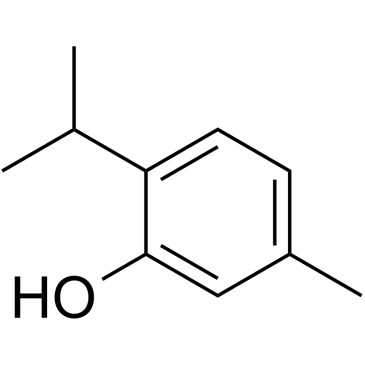125-20-2
| 中文名 | 百里酚酞 |
|---|---|
| 英文名 | Thymolphthalein |
| 中文别名 |
麝香草酚麸
5',5''-二异丙基-2',2''-二甲基酚酞 麝香草酚酞 百里香酚酞 |
| 英文别名 |
Thymolphthalein
MFCD00005909 3,3-Bis[4-hydroxy-2-methyl-5-(1-methylethyl)phenyl]-1(3H)-isobenzofuranone 3,3-Bis(4-hydroxy-5-isopropyl-2-methylphenyl)-2-benzofuran-1(3H)-one TCMDC-123951 3,3-bis(4-hydroxy-2-methyl-5-propan-2-ylphenyl)-2-benzofuran-1-one EINECS 204-729-7 5',5''-Diisopropyl-2',2''-dimethylphenolphthalein |
| 密度 | 1.2±0.1 g/cm3 |
|---|---|
| 沸点 | 571.6±50.0 °C at 760 mmHg |
| 熔点 | 251-253 °C(lit.) |
| 分子式 | C28H30O4 |
| 分子量 | 430.535 |
| 闪点 | 187.5±23.6 °C |
| 精确质量 | 430.214417 |
| PSA | 66.76000 |
| LogP | 6.23 |
| 外观性状 | 白色结晶粉末 |
| 蒸汽压 | 0.0±1.6 mmHg at 25°C |
| 折射率 | 1.613 |
| 储存条件 | 贮存:密封保存。 |
| 稳定性 | 基本性质:遇酸碱变色 |
| 水溶解性 | insoluble |
| 分子结构 | 1、 摩尔折射率:126.12 2、 摩尔体积(cm3/mol):362.4 3、 等张比容(90.2K):961.6 4、 表面张力(dyne/cm):49.5 5、 极化率(10-24cm3):50.00 |
| 计算化学 | 1.疏水参数计算参考值(XlogP):6.8 2.氢键供体数量:2 3.氢键受体数量:4 4.可旋转化学键数量:4 5.互变异构体数量:45 6.拓扑分子极性表面积66.8 7.重原子数量:32 8.表面电荷:0 9.复杂度:636 10.同位素原子数量:0 11.确定原子立构中心数量:0 12.不确定原子立构中心数量:0 13.确定化学键立构中心数量:0 14.不确定化学键立构中心数量:0 15.共价键单元数量:1 |
| 更多 | 1.性状:无色针状结晶或白色至淡黄色结晶性粉末。 2.熔点:251-252℃(分解) 3.溶解性:溶于乙醇、丙酮,溶于稀碱呈蓝色,溶于硫酸呈胭脂红色,不溶于水。 |
Synonym:Non Section 2 - COMPOSITION, INFORMATION ON INGREDIENTS
Risk Phrases: None Listed. Section 3 - HAZARDS IDENTIFICATION EMERGENCY OVERVIEW
The toxicological properties of this material have not been fully investigated. Potential Health Effects Eye: Dust may cause mechanical irritation. Skin: May cause skin irritation. Ingestion: The toxicological properties of this substance have not been fully investigated. Inhalation: Inhalation of dust may cause respiratory tract irritation. Chronic: No information found. Section 4 - FIRST AID MEASURES Eyes: Flush eyes with plenty of water for at least 15 minutes, occasionally lifting the upper and lower eyelids. Get medical aid immediately. Skin: Flush skin with plenty of water for at least 15 minutes while removing contaminated clothing and shoes. Get medical aid if irritation develops or persists. Ingestion: If victim is conscious and alert, give 2-4 cupfuls of milk or water. Never give anything by mouth to an unconscious person. Get medical aid immediately. Inhalation: Remove from exposure and move to fresh air immediately. If not breathing, give artificial respiration. If breathing is difficult, give oxygen. Get medical aid if cough or other symptoms appear. Notes to Physician: Section 5 - FIRE FIGHTING MEASURES General Information: As in any fire, wear a self-contained breathing apparatus in pressure-demand, MSHA/NIOSH (approved or equivalent), and full protective gear. Dusts at sufficient concentrations can form explosive mixtures with air. During a fire, irritating and highly toxic gases may be generated by thermal decomposition or combustion. Extinguishing Media: For small fires, use dry chemical, carbon dioxide, water spray or alcohol-resistant foam. Section 6 - ACCIDENTAL RELEASE MEASURES General Information: Use proper personal protective equipment as indicated in Section 8. Spills/Leaks: Clean up spills immediately, observing precautions in the Protective Equipment section. Sweep up, then place into a suitable container for disposal. Avoid generating dusty conditions. Provide ventilation. Section 7 - HANDLING and STORAGE Handling: Wash thoroughly after handling. Remove contaminated clothing and wash before reuse. Minimize dust generation and accumulation. Avoid contact with eyes, skin, and clothing. Avoid ingestion and inhalation. Use with adequate ventilation. Storage: Keep container closed when not in use. Store in a tightly closed container. Store in a cool, dry, well-ventilated area away from incompatible substances. Section 8 - EXPOSURE CONTROLS, PERSONAL PROTECTION Engineering Controls: Use adequate ventilation to keep airborne concentrations low. Exposure Limits CAS# 125-20-2: Personal Protective Equipment Eyes: Wear appropriate protective eyeglasses or chemical safety goggles as described by OSHA's eye and face protection regulations in 29 CFR 1910.133 or European Standard EN166. Skin: Wear appropriate protective gloves to prevent skin exposure. Clothing: Wear appropriate protective clothing to prevent skin exposure. Respirators: Follow the OSHA respirator regulations found in 29 CFR 1910.134 or European Standard EN 149. Use a NIOSH/MSHA or European Standard EN 149 approved respirator if exposure limits are exceeded or if irritation or other symptoms are experienced. Section 9 - PHYSICAL AND CHEMICAL PROPERTIES Physical State: Solid Color: white Odor: Not available. pH: Not available. Vapor Pressure: Not available. Viscosity: Not available. Boiling Point: Not available. Freezing/Melting Point: 250 deg C Autoignition Temperature: Not available. Flash Point: Not available. Explosion Limits, lower: Not available. Explosion Limits, upper: Not available. Decomposition Temperature: Solubility in water: Insoluble in water. Specific Gravity/Density: Molecular Formula: C28H30O4 Molecular Weight: 430.2076 Section 10 - STABILITY AND REACTIVITY Chemical Stability: Stable. Conditions to Avoid: Incompatible materials, dust generation, strong oxidants. Incompatibilities with Other Materials: Strong oxidizers. Hazardous Decomposition Products: Carbon monoxide, carbon dioxide. Hazardous Polymerization: Has not been reported. Section 11 - TOXICOLOGICAL INFORMATION RTECS#: CAS# 125-20-2 unlisted. LD50/LC50: Not available. Carcinogenicity: Thymolphthalein - Not listed by ACGIH, IARC, or NTP. Section 12 - ECOLOGICAL INFORMATION Ecotoxicity: No data Section 13 - DISPOSAL CONSIDERATIONS Dispose of in a manner consistent with federal, state, and local regulations. Section 14 - TRANSPORT INFORMATION IATA Not regulated as a hazardous material. IMO Not regulated as a hazardous material. RID/ADR Not regulated as a hazardous material. Section 15 - REGULATORY INFORMATION European/International Regulations European Labeling in Accordance with EC Directives Hazard Symbols: Not available. Risk Phrases: Safety Phrases: S 24/25 Avoid contact with skin and eyes. WGK (Water Danger/Protection) CAS# 125-20-2: 2 Canada CAS# 125-20-2 is listed on Canada's DSL List. CAS# 125-20-2 is not listed on Canada's Ingredient Disclosure List. US FEDERAL TSCA CAS# 125-20-2 is listed on the TSCA inventory. SECTION 16 - ADDITIONAL INFORMATION N/A |
| 个人防护装备 | Eyeshields;Gloves;type N95 (US);type P1 (EN143) respirator filter |
|---|---|
| 危害码 (欧洲) | Xn:Harmful |
| 风险声明 (欧洲) | R40 |
| 安全声明 (欧洲) | S7-S16-S36/37-S24/25-S22 |
| 危险品运输编码 | UN 1170 3/PG 3 |
| WGK德国 | 3 |
| 包装等级 | II |
| 危险类别 | 3 |
| 海关编码 | 29322980 |
|
~90% 
125-20-2 |
| 文献:Sabnis, Ram W. Tetrahedron Letters, 2009 , vol. 50, # 46 p. 6261 - 6263 |
| 海关编码 | 2932209090 |
|---|---|
| 中文概述 | 2932209090. 其他内酯. 增值税率:17.0%. 退税率:13.0%. 监管条件:无. 最惠国关税:6.5%. 普通关税:20.0% |
| 申报要素 | 品名, 成分含量, 用途 |
| Summary | 2932209090. other lactones. VAT:17.0%. Tax rebate rate:13.0%. . MFN tariff:6.5%. General tariff:20.0% |




